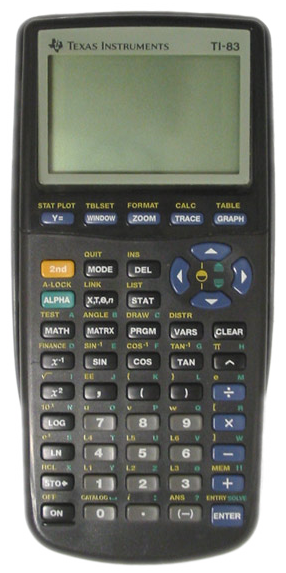In the late 1990s just before I started high school, I remember shopping in a business supply store with my mother and seeing the Texas Instruments Ti-83. I had absolutely no real need for this calculator at this age and it certainly was not required in school. But something about it caught my young eye and I asked my mother if we could buy it. Because I had taken it off of the shelf and to my mother in another part of the store to ask, she was not aware of the price of the device.She must have assumed that because it was a calculator it was not going to be too expensive, this was the end of the so-called calculator wars anyway and they were very cheap devices (however this is not the case with TI, even to this day on these very models!). She agreed and we continued shopping. I of course salivated over the copy on the box and luckily held back from opening it straight away in the store.
When my mother and I came up to the cashier to ring in whatever we were buying, she asked my mother if she was sure she wanted the calculator. She told her it was $120. My mother was shocked and told me that I couldn't have that calculator and because I must have seemed upset she offered for me to grab another. But I wasn't interested in a calculator, I was interested in whatever this beautiful and inviting thing was, and the high price just made me more intrigued.

I did not get the calculator that day. It would not be until high school when I would have the Ti-84 Plus in my hands and not because I owned it but because the school had supplied them during math class for graphing and stats. We were not allowed to take the devices home but I had a math teacher who would let me and a few friends fiddle with the devices during a spare. It was one thing to use the calculator in class, following the set instructions from the teacher (who actually barely knew how to fully use the calculator themselves), but it was another to get into BASIC programming and assembly language beyond the math. This was my very first introduction to coding and getting under the hood so to speak of a computer device. It was thrilling.
But it is kind of funny to look back now and see how little we were even into the thing. For starters, we didn't have any link cables around and we were not keen enough to consider searching the internet for programs and assembly apps written by other people. We obviously linked and exchanged programs between ourselves but that was about it. And beyond giving us the room to play with the calculators outside of class, the teacher wasn't much of a help by way of inspiring us to go deeper with fiddling.
I would end up getting more into calculators and the whole community around them. In the process I would come to learn a lot about computers and how they work. The calculator, we have to remember is the OG computer, in fact in a very basic way your super high-power gaming machine is nothing more than a very efficient number cruncher. It is a fascinating world. This is sort of what this journal will be all about and as I continue the journey of exploring more calculators.
When my mother and I came up to the cashier to ring in whatever we were buying, she asked my mother if she was sure she wanted the calculator. She told her it was $120. My mother was shocked and told me that I couldn't have that calculator and because I must have seemed upset she offered for me to grab another. But I wasn't interested in a calculator, I was interested in whatever this beautiful and inviting thing was, and the high price just made me more intrigued.

I did not get the calculator that day. It would not be until high school when I would have the Ti-84 Plus in my hands and not because I owned it but because the school had supplied them during math class for graphing and stats. We were not allowed to take the devices home but I had a math teacher who would let me and a few friends fiddle with the devices during a spare. It was one thing to use the calculator in class, following the set instructions from the teacher (who actually barely knew how to fully use the calculator themselves), but it was another to get into BASIC programming and assembly language beyond the math. This was my very first introduction to coding and getting under the hood so to speak of a computer device. It was thrilling.
But it is kind of funny to look back now and see how little we were even into the thing. For starters, we didn't have any link cables around and we were not keen enough to consider searching the internet for programs and assembly apps written by other people. We obviously linked and exchanged programs between ourselves but that was about it. And beyond giving us the room to play with the calculators outside of class, the teacher wasn't much of a help by way of inspiring us to go deeper with fiddling.
I would end up getting more into calculators and the whole community around them. In the process I would come to learn a lot about computers and how they work. The calculator, we have to remember is the OG computer, in fact in a very basic way your super high-power gaming machine is nothing more than a very efficient number cruncher. It is a fascinating world. This is sort of what this journal will be all about and as I continue the journey of exploring more calculators.